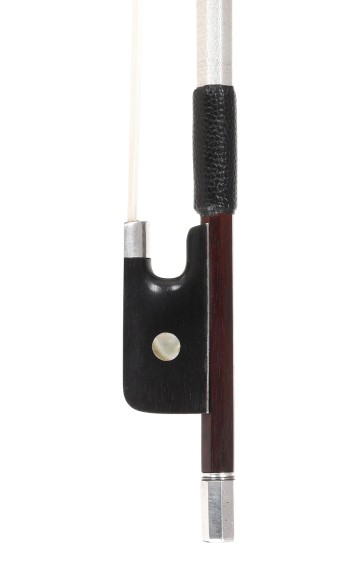The modern violin bow and the new classics of bow making in the style of the great François Xavier Tourte
While bow making in the Classical and Baroque periods was defined by many fluid shifts, the modern age of bow making has a clearly identifiable founding father and classic figurehead: François Xavier Tourte (1747/48-1835), whose reputation as the “Stradivarius of bow making” is undisputed. It is thought that François Xavier Tourte as a bow maker's son was initially trained as a watchmaker before joining his older brother Léonard' Tourte's workshop and learning the family trade.
François Xavier Tourte and the modern violin bow – Contents:
- François Xavier Tourte's violin bow design
- Playing characteristics of the modern violin bow after Tourte
- Carbon fibre bows
François Xavier Tourte's violin bow design
François Xavier Tourte's violin bow design took the accomplishments of Classical bow making and perfected them, always with an eye to the growing demands of the era's soloists. One of his earliest innovations still stands the test of time: he used premium pernambuco wood. This permitted François Xavier Tourte to apply complicated physics to the shape of the stick, and as a natural material the wood remains unequalled to this day. The logarithmic narrowing of the later-period Tourte violin bows is an exceptional and historical achievement in terms of mathematical complexity and the related challenges in mechanical accuracy. It was not until a generation had passed that the great Jean-Baptiste Vuillaume (1798-1875) managed to comprehend and describe the precision of Tourte bows.
Playing characteristics of the modern violin bow after Tourte
The massive successes which François Xavier Tourte enjoyed even during his lifetime were not solely due to the mathematical sophistication of his bows; they were also attributed to the ideal playing characteristics he made possible. The F.X. Tourte bow was perfectly balanced and had a quick and agile response because of its strong inward arch. This bow offered the largest spectrum of playing techniques ever encountered — from full cantabile playing to newer spiccato techniques such as saltando, ricochet and sautillé. François Xavier Tourte perfected every aspect of the model, including the contours of the head and the mounting for the horsehair, which he widened and increased. Much like Cremonese violins, F. X. Tourte's style was only marginally modified by other craftsmen. The most significant heirs of his legacy include the “German Tourte,” Ludwig Christian August Bausch (1805-1871), François Nicolas Voirin (1833-1885) and, last but not least, the great Eugène Sartory (1871-1946).
Carbon fibre bows
The most recent development in modern bow making involves working with composite materials such as fibreglass and carbon fibre, which have been manufactured since the 1960s and the 1990s, respectively. In the meantime they are also available as high-quality models. The use of these materials is partially a response to the shortage of good pernambuco; this in turn is due to an expansion of agricultural areas and major construction activity which have affected the most important sites in Brazil where the pernambuco tree Caesalpina echinata is grown.
Related articles:
The bow makers of Markneukirchen
H. R. Pfretzschner – a biographical sketch<7a>
Ludwig Bausch: the "German Tourte"
Morizot père et frères: The short history of a great family of bow makers
Eugène Nicolas Sartory – a modern classic among bow makers
Bazin – The turbulent history of a great violin bow maker dynasty (two parts)
Joseph Alfred Lamy Père – a key figure in modern bow making
James Tubbs: the classic name in English bow making
John Dodd – a legend of oyster shells and silver spoons
Originally published by Corilon violins.





